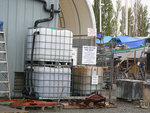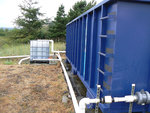The Port of Port Townsend has identified $17.5 million in facilities work seen as necessary to protect and preserve current public assets.
Sam Gibboney, hired in April as the port's new executive …
This item is available in full to subscribers.
We have recently launched a new and improved website. To continue reading, you will need to either log into your subscriber account, or purchase a new subscription.
If you had an active account on our previous website, then you have an account here. Simply reset your password to regain access to your account.
If you did not have an account on our previous website, but are a current print subscriber, click here to set up your website account.
Otherwise, click here to view your options for subscribing.
* Having trouble? Call our circulation department at 360-385-2900, or email our support.
Please log in to continue |
|


The Port of Port Townsend has identified $17.5 million in facilities work seen as necessary to protect and preserve current public assets.
Sam Gibboney, hired in April as the port's new executive director, outlined what she called the "precarious state" of port facilities, and underscored the urgency of needed repairs outlined in the port's draft Capital Repair and Replacement Plan from December 2015. A copy of the plan is available with this story on ptleader.com.
The estimated $17.5 million in funding, said Eric Toews, port planner, is the minimum needed "to attain a state of good repair." The sites of many of the proposed projects were visited during an Aug. 17 public tour of capital facilities.
The urgency of many of these repairs deemed necessary to preserve public infrastructure is why the port is so intent on getting a handle on the totality of its capital repair needs, Gibboney said.
Many nearby port districts have far greater tax bases than the Port of Port Townsend, Gibboney noted, or they benefit from long-term leases with large customers, such as Washington State Ferries. That's not the case in Jefferson County, Gibboney explained, where the port district has "a diversity of assets, but limited streams of revenue."
Gibboney noted that the port's mission is not a simple "maximize profit" equation, but that ultimately, the long-term viability of the port "sustains and extends the economic viability of the community."
BONDING CAPACITY
One of the first questions facing the port is how to pay for urgently needed repairs. According to Gibboney, the port currently has capacity to issue as much as $6.5 million in bonds: about $3 million in limited tax general obligation bonds, based on the port's tax revenue, and another $3.5 million in revenue bonding, based on the port's non-tax income. The intention, Gibboney said, is to use bonds as matching monies to help leverage state and federal funding to keep critical infrastructure in good repair. While the port's capital repair needs are significant, Gibboney points out that "not all [costs for] these projects will be solely borne by the port itself."
Over time, Gibboney explained, maintaining infrastructure builds the port district's income capacity and supports overall economic growth in the area.
DEBT LOAD
The port's current debt obligations total about $10.5 million in principal, with payoff timelines for those obligations ranging from July 2017 through December 2029. Several of the older capital project bonds have been refinanced to take advantage of falling interest rates; Gibboney compared the refinancing to what many homeowners have done to reduce interest payments on their home mortgages.
Gibboney emphasized that the port is financially solvent and would remain so; the conversation now is how to better plan for ongoing capital repair needs over the long term.
The intention, Gibboney said, is not to point fingers about long-deferred maintenance, but to focus on the future.
"We're here now," Gibboney said. "How can we do this better in the future? How do we create systematic planning methodology that lets us see upcoming needs and program them out over time?"
Toward this end, she's recommended that the port commission create and fund a capital projects reserve fund for all port properties, similar to the fund already in place for boat haven marina repairs.
Gibboney sees the port as moving away from a "one project at a time" mentality, and instead creating planning processes to have a cohesive strategy for managing multiple projects, partnerships and funding sources on an ongoing basis. Such planning is just good asset management, Gibboney said, and one component of what she calls a "robust toolbox" for managing the port for the long term.
The port's current deferred maintenance situation is part of a nationwide trend, Gibboney noted. "Nationwide, there's been a lack of investment in upkeep and renewal of infrastructure. The port is not unique in this."
Gibboney is confident that long-term investment in critical infrastructure is the right thing to do – for the port, and for the community as a whole.
"As a community, we need to accept that we have infrastructure that dramatically improves our lives." Gibboney points to investments made by prior generations in roads, public sewer and water, and in port facilities. "We have a lineage of caretaking in our community – not only protecting what we have, but continuing to invest for the future."
STORMWATER TREATMENT
The number-one item on the port's "to do" list is improvements to stormwater treatment at the Port Townsend Boat Haven. In response to an administrative order from the state Department of Ecology, the port is spending $1 million to upgrade its boatyard stormwater filtration treatment, designed to keep heavy metals and other boatyard pollutants from entering the bay. Engineering design work for the new filtration is currently underway; the bid should go out in early 2017. To meet state boatyard permit requirements, stormwater improvements must be in place by September 2017 or the boatyard risks losing its operating permit. According to Gibboney, more than 400 people work directly or indirectly in the boat haven marine trades, making it one of the largest concentrations of employment in Jefferson County. Loss of the boatyard permit – even temporarily – would have far-reaching economic consequences for the entire region, making environmental compliance a top priority.
To properly address stormwater contaminants, the port is taking a multi-pronged approach, aggressively enforcing boatyard best management practices (BMPs) to eliminate pollution at the source, as well as improving stormwater treatment. According to Al Cairns, port environmental compliance officer, despite education and outreach efforts to improve the boatyard culture around BMPs, boat haven stormwater is still badly failing testing, with five times the allowable levels of copper and four times the allowable levels of zinc.
POINT HUDSON
The second stop on the facilities tour was the "duplex" building at Point Hudson. Like all the original 1930s buildings built for use as a federal quarantine station (and instead used as a Coast Guard training center), the duplex sits on creosote pilings. According to Gibboney, interior air quality meets safety standards, but the creosote smell is noticeable inside the closed building.
The port, Gibboney said, is trying to determine the best way to remediate the odor and improve air quality. In other Point Hudson buildings, installation of vapor barriers has helped, but odor remains an issue; at least one port tenant is citing creosote odor as a problem in renewing their five-year lease. While mitigation in the historic buildings poses difficulties, Gibboney noted that "these buildings are worth saving; they'll last another 100 years with maintenance." She added that Point Hudson is "an integral piece of our cultural heritage as a town."
Gibboney cited the port's overall mission of economic development, and of balancing that with its secondary missions of shoreline access, supporting the marine trades and historic preservation.
"Not every single building has to have a positive return," said Gibboney, "but we do need to have a positive economic cash flow overall."
Also at Point Hudson, the port intends to proceed with an estimated $6 million jetty replacement project.
BOAT HAVEN RESTROOMS
The primary restroom/shower facilities at the Port Townsend Boat Haven were the next tour stop. Why the bathrooms? According to Gibboney, port staff fields more calls about the boat haven restrooms than any other port facility. The site is effectively serving as a "hygiene center" for the community, providing 53,000 showers a year. Fewer than 50 people actually live aboard in the marina; the vast majority of shower usage is by people who are not port tenants.
Gibboney noted the strong community need for a public hygiene center offering showers, but the solution needs to be a partnership with the city and other service agencies, not just sending people to "go shower at the port."
Repair needs at the restroom facility include mold abatement and improved roof venting.
Currently, boat haven restrooms are open during normal working hours, and accessed via a numeric keypad on evenings and weekends; the key code is widely shared with non-tenants. The port, while sensitive to the community's need for a public place to shower, is investigating a possible changeover to an electronic key-card system to reduce vandalism and overuse.
C/D DOCK REPAIRS
Unlike the Point Hudson jetty, the port has opted to repair rather than replace the aging C/D dock floats. The docks, built in the 1970s and designed for a 35-year lifespan, did not originally include utilities. The main floats were recoated in 2013, with new sideboards added; the finger and side piers have not yet been redone. The cost for full replacement of the C/D docks and the linear dock is estimated at $8 million. In comparison, repair of the wooden sidebars and the recoating of concrete on the finger and side piers would cost $1.6 million and should extend the life of the docks for 10 more years, Gibboney said. The A/B docks were replaced in the 2010-11 for $4.3 million.
BOATYARD SIDEWALK
Gibboney noted that while the community enjoys having an "open boatyard," the port facilities don't provide well for pedestrians and bicycles. The tour group had just walked a block down the center of Washington Street at the boat haven, underscoring Gibboney's point. The existing boat haven waterfront sidewalk – narrow, frequently blocked by parked cars and used as a de facto dog walk area – is inadequate to meet current needs.
"Let's plan for access," Gibboney said, envisioning better connection between the boat haven and downtown, and improved pedestrian access within the boatyard, separating foot traffic, including Larry Scott Trail users, from circulating through boatyard work areas and keeping pedestrians out of the path of the mobile boat hoists.
PROJECTS COUNTYWIDE
While the capital projects tour concentrated on port properties in Port Townsend, Gibboney emphasized that the port is "not just District 1, and not just marine trades." She cited Port of Skagit's expansion into the processing of agricultural products as an example of a port district "doing things that may not come to mind" when thinking about a port.